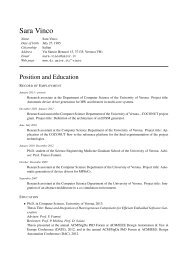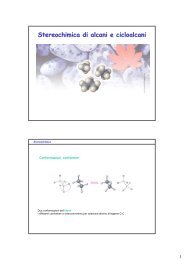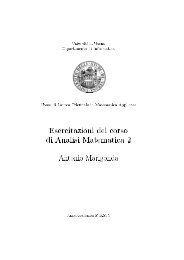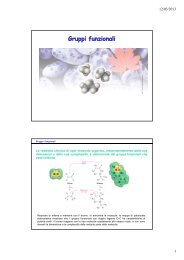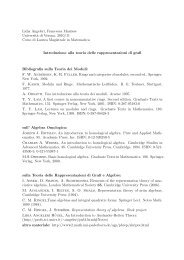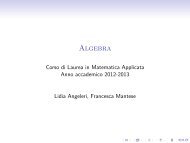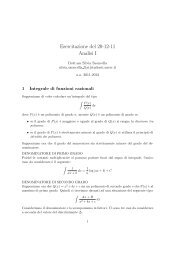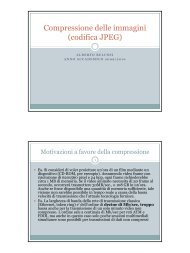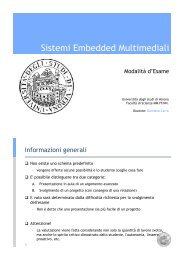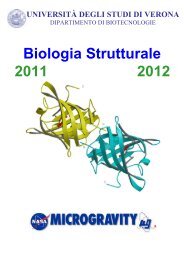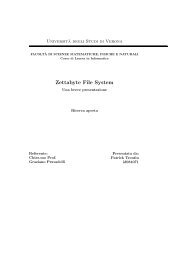You also want an ePaper? Increase the reach of your titles
YUMPU automatically turns print PDFs into web optimized ePapers that Google loves.
224 I. FUNZIONI TRIGONOMETRICHE ED IPERBOLICHE<br />
P = (x, y). Consideriamo l’area della regione delim<strong>it</strong>ata da tale semiretta, dall’asse x e dall’iperbole, detta<br />
settore iperbolico. Diremo che (x, y) = (cosh θ, sinh θ) se e solo se tale area (con segno) è θ/2, nel senso<br />
che per θ ≥ 0 stiamo considerando un settore iperbolico giacente nel primo quadrante di area θ/2, mentre<br />
per θ < 0 stiamo considerando un settore iperbolico nel quarto quadrante di area |θ|/2. Rimangono defin<strong>it</strong>e<br />
quindi due funzioni: cosh : R → [1, +∞[ (coseno iperbolico e sinh : R → R (seno iperbolico). Si può inoltre<br />
definire tanh : R → ] − 1, 1[ (tangente iperbolica) ponendo tanh(x) = sinh(x)<br />
cosh(x) . Analogamente, è possibile definire<br />
coth : R \ {0} → R\] − 1, 1[ (cotangente iperbolica) ponendo coth(x) = cosh(x)<br />
sinh(x) .<br />
Per completezza c<strong>it</strong>iamo anche le funzioni sech : R → [0, 1] (secante iperbolica) e csc : R \ {0} → R (cosecante<br />
iperbolica) defin<strong>it</strong>e da sec(x) = 1<br />
1<br />
cosh(x) e csc(x) = sinh(x) . Si possono dare le definizioni di tutte queste funzioni<br />
in termini di funzioni esponenziali, tali definizioni si trovano nella tabella allegata. Tali espressioni permettono<br />
di estendere le definizioni di queste funzioni al campo complesso. A partire da tali definizioni è possibile dare<br />
le espressioni delle funzioni iperboliche inverse:<br />
Le derivate di queste funzioni sono date da:<br />
arcsinh(x) = sinh −1 <br />
(x) = log x + x2 <br />
+ 1<br />
arccosh(x) = cosh −1 <br />
(x) = log x + x2 <br />
− 1 , x ≥ 1<br />
arctanh(x) = tanh −1 √ <br />
1 − x2 (x) = log<br />
=<br />
1 − x<br />
1<br />
2 ln<br />
<br />
1 + x<br />
, |x| < 1<br />
1 − x<br />
arcoth(x) = coth −1 √ <br />
x2 − 1<br />
(x) = log<br />
=<br />
x − 1<br />
1<br />
2 ln<br />
<br />
x + 1<br />
, |x| > 1<br />
x − 1<br />
arcsech(x) = sech −1 √ <br />
1 ± 1 − x2 (x) = log<br />
, 0 < x ≤ 1<br />
x<br />
arccsch(x) = csch −1 √ <br />
1 ± 1 + x2 (x) = log<br />
.<br />
x<br />
d<br />
sinh(x) = cosh(x)<br />
dx<br />
d<br />
cosh(x) = sinh(x)<br />
dx<br />
d<br />
dx tanh(x) = 1 − tanh2 (x) = sech 2 (x) = 1/ cosh 2 (x)<br />
d<br />
dx coth(x) = 1 − coth2 (x) = −csch 2 (x) = −1/ sinh 2 (x)<br />
d<br />
csch(x) = − coth(x)csch(x)<br />
dx<br />
d<br />
sech(x) = − tanh(x)sech(x)<br />
dx<br />
d −1 1<br />
sinh x = √<br />
dx<br />
x2 + 1<br />
d −1 1<br />
cosh x = √<br />
dx<br />
x2 − 1<br />
d −1 1<br />
tanh x =<br />
dx<br />
1 − x2 d −1 1<br />
csch x = −<br />
dx<br />
|x| √ 1 + x2 d −1 1<br />
sech x = −<br />
dx<br />
x √ 1 − x2 d −1 1<br />
coth x =<br />
dx<br />
1 − x2



